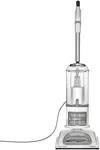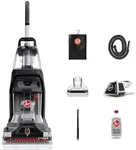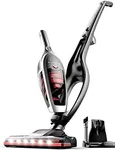Buying Guide for the Best Pet Vacuum Cleaners
Choosing the right pet vacuum cleaner can make a significant difference in maintaining a clean home, especially if you have furry friends. Pet vacuum cleaners are designed to handle pet hair, dander, and the occasional mess that comes with having pets. When selecting a pet vacuum cleaner, it's important to consider various specifications to ensure it meets your needs and makes cleaning easier and more efficient.Suction PowerSuction power is a measure of how effectively a vacuum can pick up dirt, debris, and pet hair from various surfaces. This is important because pet hair can be stubborn and difficult to remove, especially from carpets and upholstery. Suction power is often measured in watts or air watts. Higher suction power means better cleaning performance. If you have multiple pets or pets that shed a lot, look for a vacuum with high suction power. For homes with minimal shedding, a moderate suction power should suffice.
Filtration SystemThe filtration system in a vacuum cleaner determines how well it can trap dust, allergens, and pet dander. This is crucial for maintaining good air quality, especially if anyone in your household has allergies or asthma. HEPA (High-Efficiency Particulate Air) filters are the gold standard, as they can capture 99.97% of particles as small as 0.3 microns. If allergies are a concern, opt for a vacuum with a HEPA filter. For general use, a vacuum with a good multi-stage filtration system should be adequate.
Brush RollThe brush roll, or beater bar, is the part of the vacuum that agitates carpet fibers to loosen dirt and hair. This is particularly important for pet owners because pet hair can get deeply embedded in carpets. Some vacuums come with tangle-free brush rolls designed to prevent hair from wrapping around the brush. If you have carpets or rugs, look for a vacuum with a powerful brush roll. For homes with hard floors, a vacuum with a switchable brush roll or a soft brush roll may be more suitable.
Attachments and AccessoriesAttachments and accessories can enhance the versatility of your vacuum cleaner, making it easier to clean different surfaces and hard-to-reach areas. Common attachments for pet vacuums include pet hair tools, upholstery brushes, and crevice tools. These are important for cleaning furniture, stairs, and tight spaces where pet hair tends to accumulate. Consider what areas you need to clean and choose a vacuum with the appropriate attachments. If you have a variety of surfaces, a vacuum with multiple attachments will be more useful.
Bagged vs. BaglessVacuum cleaners come in two main types: bagged and bagless. Bagged vacuums use disposable bags to collect dirt and debris, while bagless vacuums use a dustbin that needs to be emptied regularly. Bagged vacuums are generally better at containing dust and allergens, making them a good choice for allergy sufferers. Bagless vacuums are more convenient and cost-effective since you don't need to buy replacement bags. Consider your preference for convenience versus allergen control when choosing between bagged and bagless.
Weight and ManeuverabilityThe weight and maneuverability of a vacuum cleaner affect how easy it is to use, especially if you need to carry it up and down stairs or move it around furniture. Lightweight vacuums are easier to handle and less tiring to use. Maneuverability is also important for reaching under furniture and cleaning tight spaces. If you have a large home or multiple floors, a lightweight and highly maneuverable vacuum will be more practical. For smaller spaces, weight may be less of a concern.
Noise LevelThe noise level of a vacuum cleaner can be an important consideration, especially if you have pets that are sensitive to loud noises. Noise levels are measured in decibels (dB). Quieter vacuums typically produce less than 70 dB, while louder models can exceed 80 dB. If your pets are easily frightened or you prefer a quieter cleaning experience, look for a vacuum with a lower noise level. For general use, the noise level may be less of a concern.





















